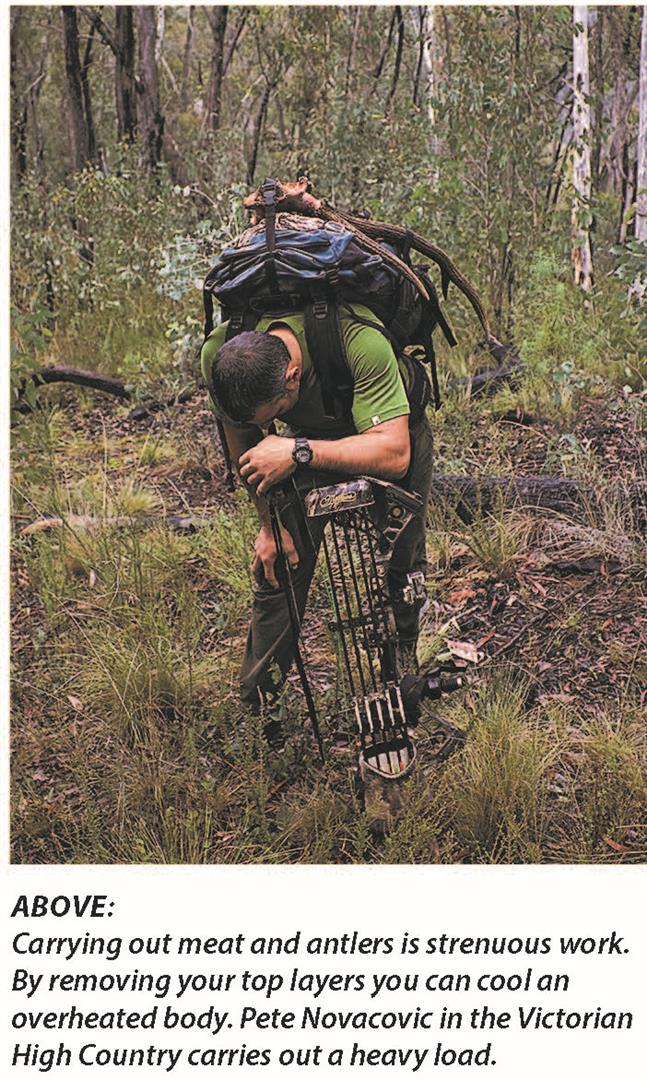$0.00
No products in the cart.
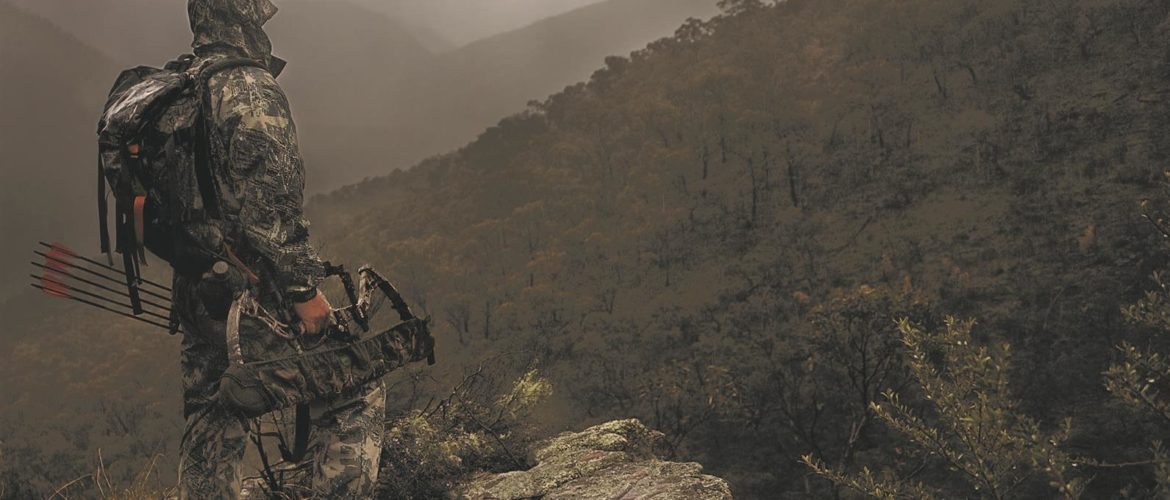
In cold environments, the ability to remain comfortable can be considered crucial to the hunter who wants to be successful. For it can be difficult to remain focussed while stalking game if you are shivering with cold. Likewise, attempting to glass game from a high ridge can be hard to do if there is a cold breeze
cutting through your damp clothing. In both situations, the cold discomfort can lead to lost opportunities as you become less diligent, as your technique becomes sloppy & your focus levels drop.
The knowledgeable hunter however, can greatly enhance the control of his core body temperature through a proper selection of clothing layers. Layering clothing allows the hunter to regulate his body temperature as he either heats up from exertion or chills due to the surrounding atmospheric conditions. This can in turn increase his comfort levels. This enhanced comfort can also lead to better concentration levels where the same environmental conditions would defeat the ill prepared.
One of the pitfalls of dressing without layers is the inability to regulate thermal comfort levels as activity or temperature changes. As an example, you may be too hot when wearing one heavy jacket, but too cold if you take it off. Successful layering can allow the hunter to remove layers during high exertion
activities such as climbing, or add layers during more sedate times such as glassing or slow stalking.
Before we discuss the layering system and suitable clothing layering techniques for the hunter in cool to cold environments, it may be beneficial to first get a basic overview of how we lose body heat. There are five methods in which your body will lose heat, depending on circumstances these may also work in combination with each other. They are as follows:
• Convective heat loss
• Conductive heat loss
• Evaporative heat loss
• Radiative heat loss
• Respiratory heat loss
Convective Heat Loss:
Convective heat loss is the process where the warm air next to the skin and/or throughout the clothing system of a hunter is displaced by the cold air of the outside environment. Wind can be considered the biggest factor to convective heat loss for the hunter in cool environments as it disrupts the thermal boundary layer existing around your body through a process known as forced convection. Most people will know this as “wind chill factor”. Passive or natural convective heat loss can occur when warm body air within your clothing system is drawn away to the cooler outside environment. This may occur through the natural movement of air as it rises inside a loose fitting garment, entering at the hem and cuff’s, and escaping through the collar. This process is often referred to as the “chimney effect”.
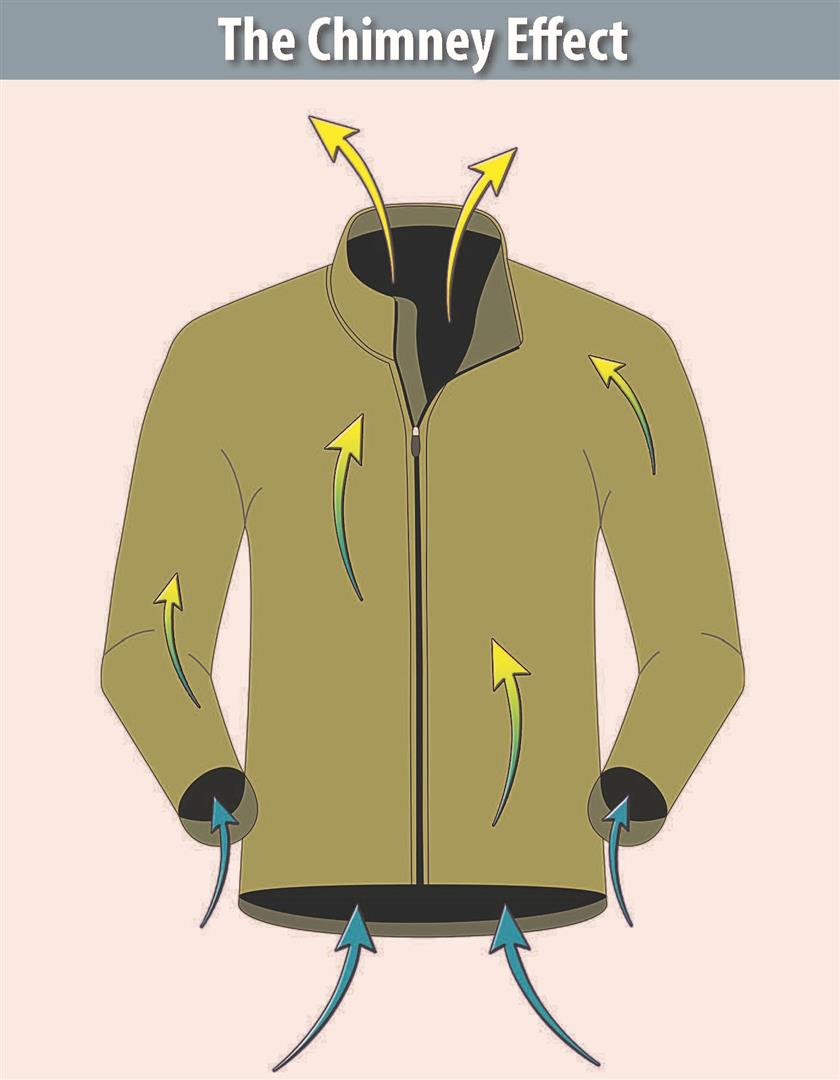
Conductive Heat Loss:
Conductive heat loss will result when there is a transfer of heat between a warm object & a cold object when the two are in direct contact with each other. A hunter sitting on the ground whether in a blind or glassing on a ridge will experience conductive heat loss as his body heat is displaced by that of the cold
ground.
Evaporative Heat Loss:
This type of heat loss can occur with wet clothing, or moisture (sweat) on your skins surface. Water conducts heat away from your body 25 times faster that air. To change from a liquid to gas state (evaporation), water requires energy. When moisture on your skins surface or within your clothing system
evaporates, it draws energy warmth from your body to complete the transformation. While this process can be beneficial in warm environments as it helps cool an overheated body, in cool environments it can quickly lead to chilling. If uncontrolled it may progress to a potentially dangerous hypothermic state.
Heat Loss through Radiation:
When the ambient air temperature is below that of the human body, heat loss through radiation will result as body warmth is lost to the surrounding atmosphere. This may become more prominent after sunset as the atmosphere no longer gains warmth from the suns rays. A hunter dressed with a proper selection of winter clothes can greatly offset the cold discomfort associated with radiant heat loss.
Heat Loss through Respiration:
Respiratory heat loss will occur when air from a cold environment is breathed in, warmed internally, then exhaled back into the atmosphere as warm moist air. This form of heat loss cannot be considered very significant for the hunter in anything but extremely cold arctic conditions.
The layering system
The basic layering concept comprises of a three piece system. This can be adjusted slightly with additional layers included based on the individual hunters experience, preferences and anticipated weather
conditions. The core layering system however, will generally comprise of three layers. As this article is intended as a general overview, we will deal primarily with a three layer combination system.
The Base Layer (Moisture management):
Many hunters can often overlook this layer, as it is an item of clothing that is not usually visible and often does not lead to concealment through camouflage as it is always worn as an undergarment. However, the base layer can be considered a crucial item of clothing in cold environments as it can significantly
reduce the effects of evaporative heat loss when you sweat, inturn making you feel warmer.
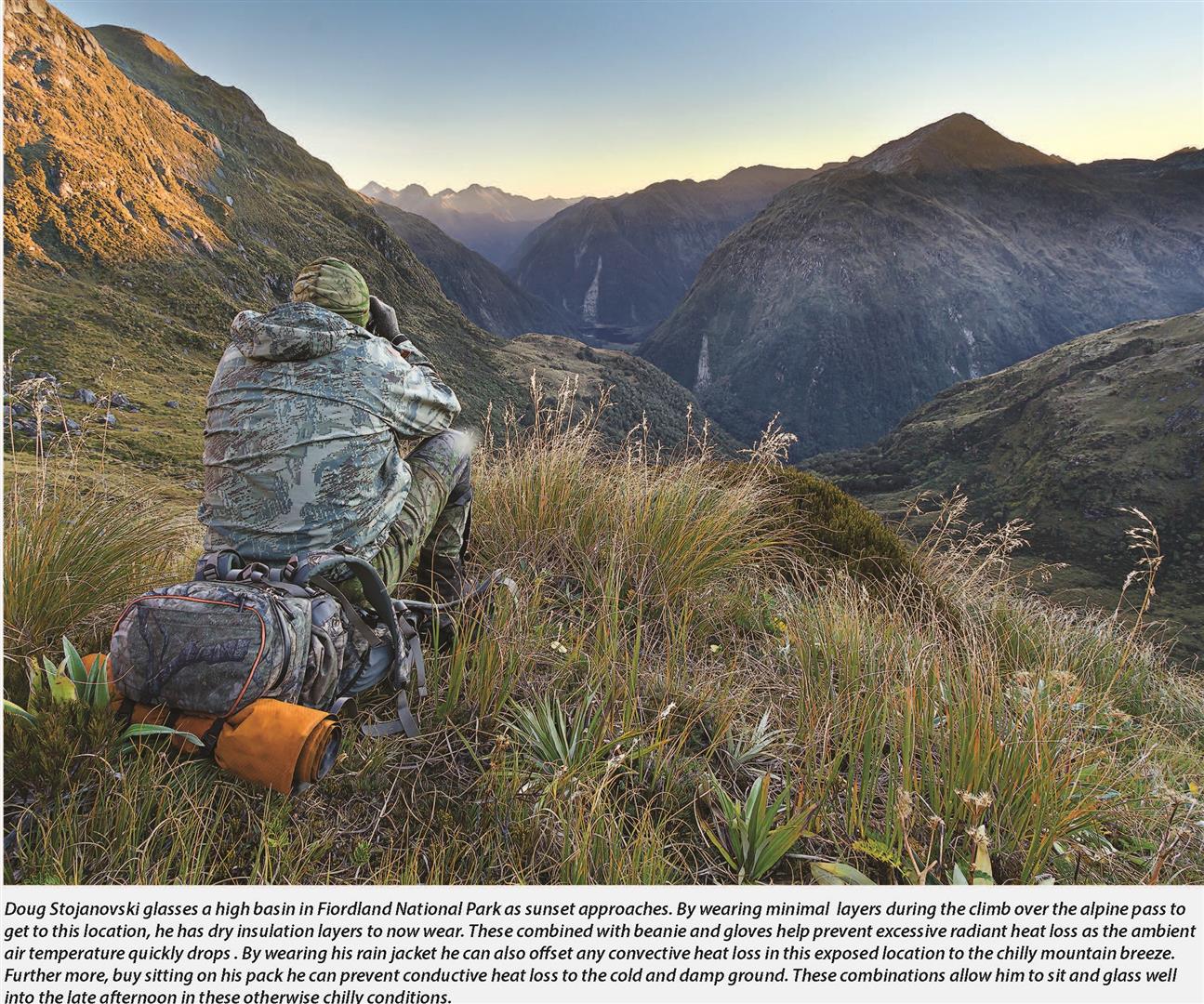
The base layer is the first layer you will dress in and is worn next to skin. Its main purpose is moisture management, that is, the ability to move your sweat away from your skin and to dry quickly. It is not there to necessarily create insulation, as this can be achieved by the layers worn above it. Through a process known as capillary action the baselayer is designed to transport the sweat on the surface of your skin to the outer side of the garment where it can disperse and eventually evaporate. For the base layer to gain the best wicking effect it should be worn in a fitted to semifitted state.
In order to achieve the desired performance results of a baselayer, fabric selection is critical. Most leading authorities dealing with outdoor wear consider cotton to be a bad choice as a next to skin garment, it is a very moisture absorbent fabric and has slow drying times. There are generally two categories of baselayer fabrics used by the outdoor industry; natural fibre & synthetic.
Merino wool is today the main natural fibre produced for baselayer construction, Traditionally wool has not been used as a next to skin fabric due to its irritating abrasive qualities. However, the advent of superfine merino wool has changed this. Superfine wool generally consists of individual fibres at or below 18.5 microns, this makes the garment much more pleasant to wear directly against the skin. Wool has excellent odour control properties but can be slower drying when compared to some synthetic fibres.
Polyester and to a lesser degree polypropylene make up the majority of synthetic fibres offered by manufactures for the hunting consumer. These fabrics (depending on fabric weight) can have exceptional drying times and can be considered an excellent choice as a baselayer garment. Their quick drying ability can be especially useful in wet hunting environments, most especially if hunting above the bushline in high rainfall mountainous terrain where most often you will not have the opportunity to light campfires to dry clothing. These fabrics have a reputation to hold body odour, however additives included into the yarn during manufacture such as silver or bamboo particles can reduce this somewhat.
In recent years manufactures have been offering baselayer garments with blends of both synthetic and natural fibres, somewhat taking the advantages of both fabrics and including them into a single garment design.
The Mid Layer (Insulation):
The purpose of the mid layer is to retain your body warmth by trapping dead air between the base layer and the mid layer, and also within the fabric pile of the mid layer itself. Mid layer garments are designed to
be breathable while also retaining thermal insulation. A semi fitted cut will allow for capillary action moisture transfer from a moist baselayer as you sweat, while also allowing for good insulation retention. A loose fitted mid layer may not be as effective to transfer moisture from the base layer through capillary action, but may still dissipate moisture due to increased circulation or passive convection.
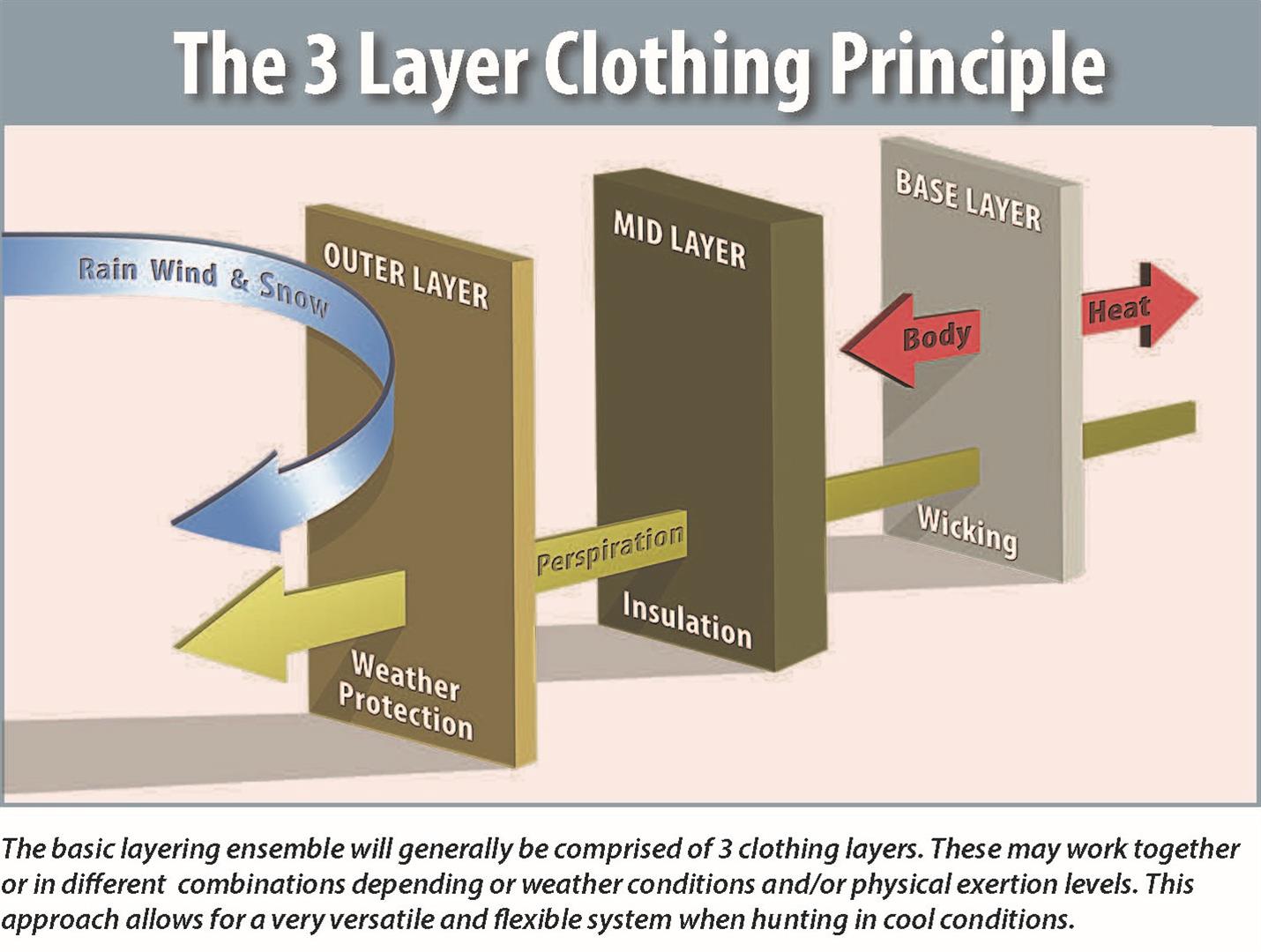
There can be a variety of options when choosing a mid layer garment, both with natural and synthetic fibre. Goose down is a tremendous insulator when considering its weight and the ability to pack down to a
very small size. However, it is generally very susceptible to moisture, as wetting down will cause it to lose its loft a render it ineffective to retain insulation. For this reason, a goose down mid layer may not be the best choice for active hunting, and may be better suited to static hunting situations such as glassing or ambush hunting. A synthetic variant of goose down, such as Primaloft, may be another option. These synthetic versions generally do not pack down as small as goose down, but deal with moisture better.
In its thicker varieties, merino wool can also be used as a mid layer, generally these mid layers are not used in very cold conditions. Very thick wool, thick enough to be used in cold environments can begin to get quite heavy and slow drying when compared to other choices.
Probably the most popular choice for a mid layer garment is one that is made from fleece. This fabric is very breathable, lightweight, quick drying and generally still retains some insulation when wet. Traditional fleece had the reputation of being very susceptible to convective heat loss (wind), however this has now been greatly improved by creating a hard face surface to the exterior by bonding a stretch woven face fabric on some varieties of fleece. Many of these hard face fleeces are also DWR (Durable Water Repellent) treated, making for a better weather resistant surface.
Outer Layer (Weather Protection):
The primary function of the outer (shell) layer is to protect you from rain, wind and snow. Outer layers are generally totally waterproof, windproof, DWR treated, have taped seams and sometimes use water resistant zippers to prevent moisture entry from these areas. Your outer layer should be loose fitting, to enable circulation & help promote the “chimney effect” while also allowing for the layers you will be wearing underneath. This is especially important if using a goose down mid layer worn underneath your outer layer, as a tighter fitted outer layer will compress the filling of a goose down jacket, rendering it ineffective.
There can be many fabric choices when considering shell outer layers. They can range from waterproof non-breathable fabrics right through to waterproof breathable fabrics. With variants of softshell and windproof fabrics also used as outer layers depending on the users requirements of weight, breathability
and anticipated weather conditions. The vast selections can sometimes seem daunting to the new hunter. Due to size constraints for this article, I will only cover the waterproof breathable family as they offer the
greatest versatility with a three-piece layering system over a wider range of environmental conditions.
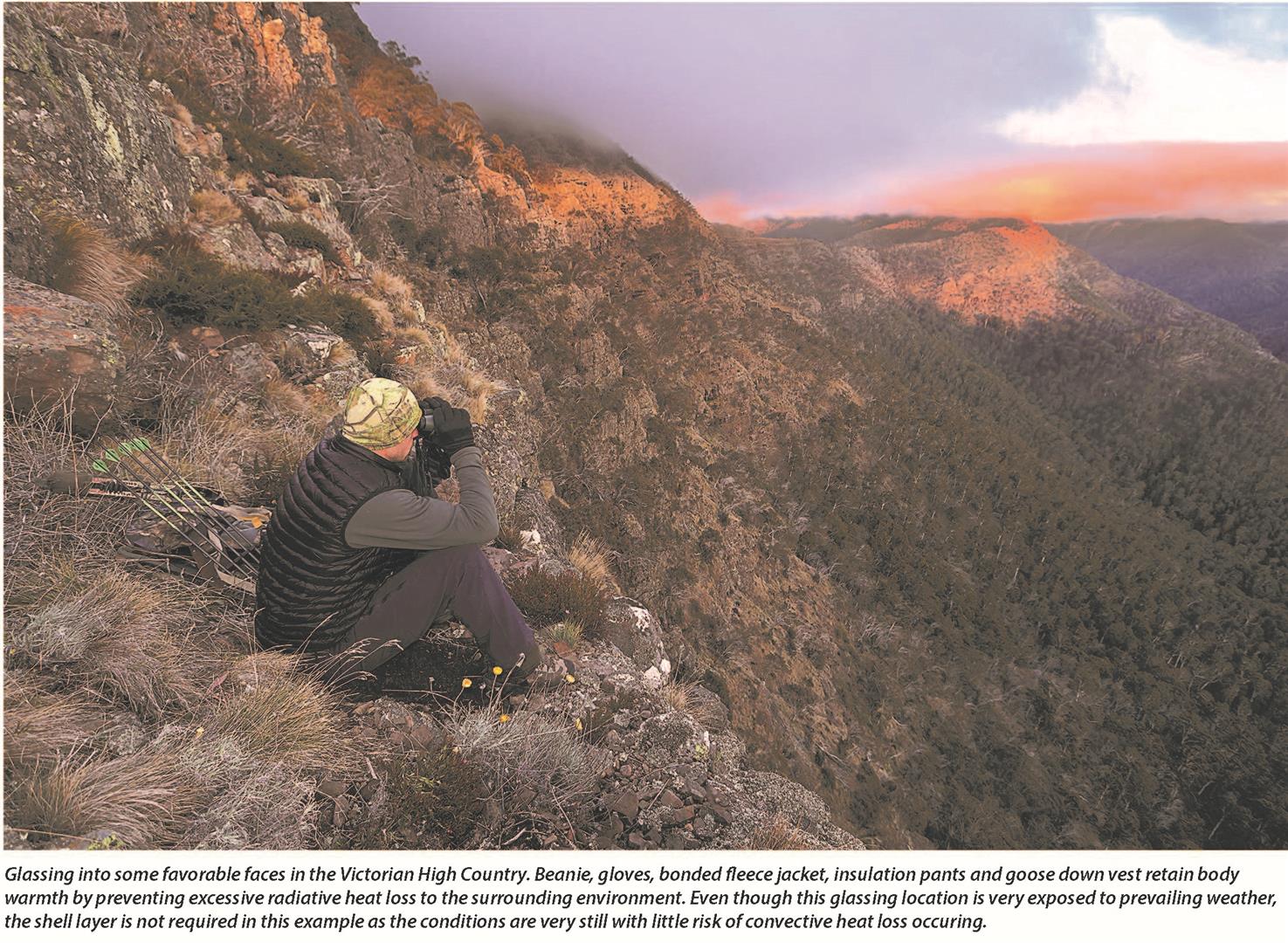
Waterproof Breathable Outer Layer
Fabric Construction:
Waterproof breathable (WP/B) outer layers offer the best versatility when used with a three piece layering system. They are generally found in three fabric weights; 2 layer, 2.5 layer and 3 layer.
The 2 layer construction generally consists of a face fabric laminated to the WP/B membrane. To protect the exposed internal membrane from abrasion, a hanging liner is used. Rain gear with this construction tend to be bulkier due to the internal liner.
The lightest weight WP/B rain gear generally use a 2.5 layer construction. These products will often use a lightweight face fabric on the outside laminated to the WP/B membrane. Internally they will often have a raised printed pattern to slightly lift the membrane off the user and create some protection from abrasion. They offer good packing ability due to their lighter construction, but can be less durable. They can be a good choice for the hunter who wants to save every gram of weight in his pack.
The most durable WP/B raingear is the 3 layer construction, these products generally consist of a durable face fabric bonded to the WP/B membrane. To protect the membrane internally they will have a backing fabric or tricot bonded, so the three laminations take on the appearance of a single piece of fabric.
They offer better robustness compared to the 2.5 layer fabrics, but tend to be slightly heavier. This construction of raingear will generally offer the best combination of strength & breathability.
Water Proof Breathable Membranes:
The membranes used in (WP/B) fabrics can broadly be broken down into two categories; hydrophobic microsporous membranes and hydrophilic monolithic membranes. Each membrane transfers moisture vapour through the fabric in different ways.
Expanded Polytetrafluoroethylene (ePTFE) is one of the better known microporous membranes owing to it creation in 1978 by W.L Gore, later his brand GoreTex would become synonymous with waterproof breathable rain wear. ePTFE is a hydrophobic (water hating) compound that contains millions of microscopic pores or channels that allow internal moisture vapor to pass through the membrane. External water droplets are
restricted due to the inherent high surface tension of ePTFE. Polyester and Polyurethane (PU) are other types of compounds that may be used to create microporous membranes.
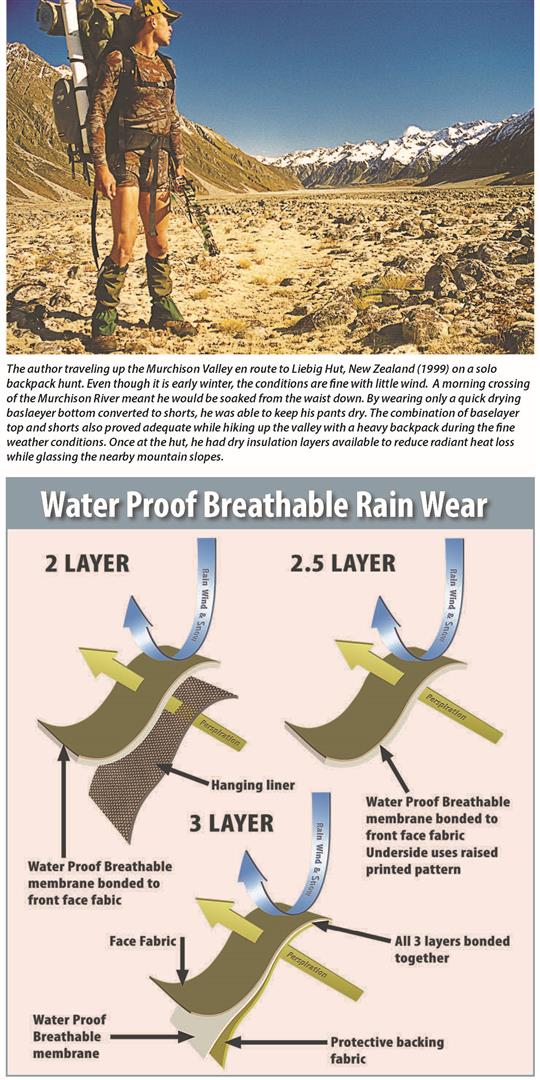
Hydrophilic monolithic membranes are solid and have no pores. They are generally applied to the face fabric as a wet coating or laminated during manufacture. If coated, as a general rule, the thicker the coating the more waterproof and less breathable the fabric will be. While thinner coatings will result in higher breathability but lower water proofness. Many of these membranes are manufactured using PU or some variants such as TPU (Thermoplastic Polyurethane).
These monolithic membranes are hydrophilic or water loving, as there are no pores, moisture vapor passes through this membrane via a process known as absorption-diffusion-desorption. To illustrate how this
membrane “breathes”, imagine an absorbent material such as a sponge laid onto a thin pool of water. In time, water will eventually pass completely through the sponge and soak it via the method of absorption. In order for diffusion to take place there needs to exist a differential gradient. Areas of high humidity will always be drawn to areas of low humidity, just as hot air is drawn to cold. A hunter under physical exertion will create a warm humid climate inside the jacket, compared to the cooler less humid conditions of the outside environment. This differential gradient between the inside of the jacket and the outside environment will force the moisture vapour through the membrane. Finally desorption occurs with the moisture molecules, having passed through the membrane and fabric layers, evaporating into the outside atmosphere.
Putting it all together–A basic guide to layering
The big advantage of a layering system is the users ability to shed or apply layers depending on weather conditions or physical exertion levels. Now that we have a basic understanding of heat loss and layering principles, we will construct a typical hunting scenario to demonstrate the use of a basic three layer
clothing system.
In a mountain valley during a cool weather period, a hunter waits in camp for first light to break. He is camped down by the river and it has rained overnight, but it looks like it will clear to become a fine day. To guard against radiant heat loss in the pre dawn light he will be wearing both his base and mid layers. Once light breaks he begins to move, his objective for the day is to climb onto a saddle and glass
off a nearby rock outcrop where he knows from experience he can look into some favourable sunny faces.
As he travels, the forest understory begins to get thick and due to the previous nights rain everything is wet, brushing beside tree saplings rains down many droplets. Before he gets his mid layer wet, he takes o his pack and puts on both his outer layers (jacket and overpants). With the jacket hood also over his head he can now move freely without risk of getting wet.
Eventually he reaches the spur he will use to climb towards the saddle. As he ascends he soon leaves the wet thicker understory, his exertion level has now increased also, which is causing him to get hot wearing his outer layer. As there is now little risk of getting wet from the soaked understory, he stops and takes off both outer layers (jacket and overpants) and puts them inside his pack. With his mid layer hunting jacket now fully unzipped he continues to climb. He monitors his pace to not overheat unnecessarily, the combination of baselayers with unzipped mid layer proves adequate for this gradient of slope, the hunters ascending pace and his fitness level.
Soon he reaches a steep rocky climb 100 metres from the saddle, he is on the lee side of the ridge, and there is little breeze. As he continues to climb he begins to pant and perspire, the slope is quite steep. He stops and takes off his mid layer jacket, continuing to climb with only his base layer top.
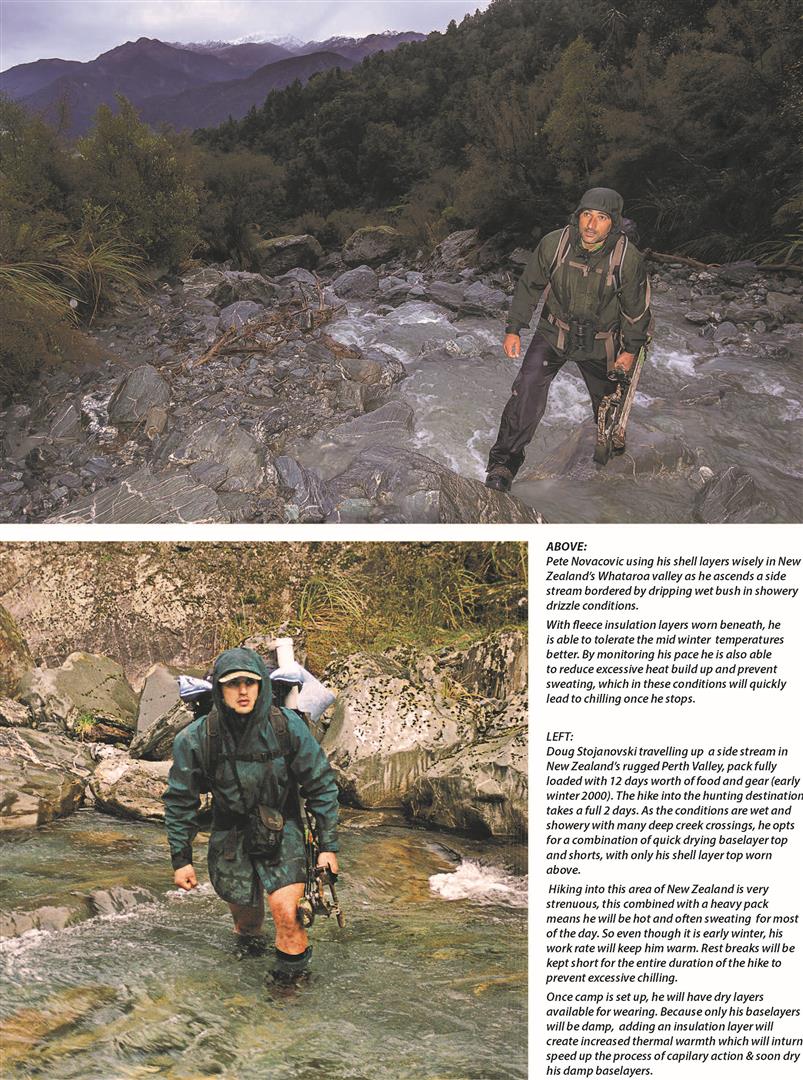
When he reaches the saddle he is perspiring freely, sweat is running down his face. On the saddle itself he is now met by the prevailing weather, the breeze is quite strong and cold on the exposed saddle but he is still very hot from his climb. Even though it does provide some momentary relief form the hot and sweaty climb, he knows from experience that it will quickly lead to chill. He takes his pack off and puts on his mid layer, zips it up according to his comfort level and continues on to the rock outcrop.
Once on the outcrop he takes his pack off, sits down and begins glassing with his binoculars. The location he is on is very exposed and the breeze is quite strong in this area. He is glad he took the time to put on his outer layers early in the morning, because his mid layers are now dry. Had he not put on his outer layers then, he would now be faced with a situation of trying to glass with wet clothing in an exposed area with a strong cold breeze.
This combination of both convective and conductive heat loss would very quickly chill him, making it very difficult for him to concentrate on the task at hand. Because he is wearing a fast drying baselayer
combined with a well fitted mid layer, capillary action soon begins to dry his damp sweaty base layer. He continues to glass, but has not spotted any game. Still he must be vigilant and persevere, he knows from experience this is a favoured location for game to move up into as they feed their way up off the
valley floor.
He has been sitting and glassing here for a little while, the heat he experienced during his morning climb has now gone. The breeze has not let up and he is feeling his comfort level drop as he begins to feel slightly cold. Immediately he takes both his outer layers out of his pack and puts them both on. With his outer layer jacket zipped up and hood over his head, the hunter has created a barrier to convective heat loss. Because he was careful to keep his mid layers dry, they are now capable to work at optimum efficiency and insulate him well.
The hunter spends the whole day on the rocky outcrop, the position allows him to survey a big area and he is confident there are animals below him in the thicker timber. By wearing all his layers, he is able to tolerate the cold breezy conditions and continue to glass.
Then one and a half hours before sunset, the hunter spots a lone stag as it steps out of the timber and begins to feed. He is a fair way from camp, so needs to move fast. Taking both his outer layers off, he unzips his mid layer jacket front zipper and quickly begins descending towards the deer.
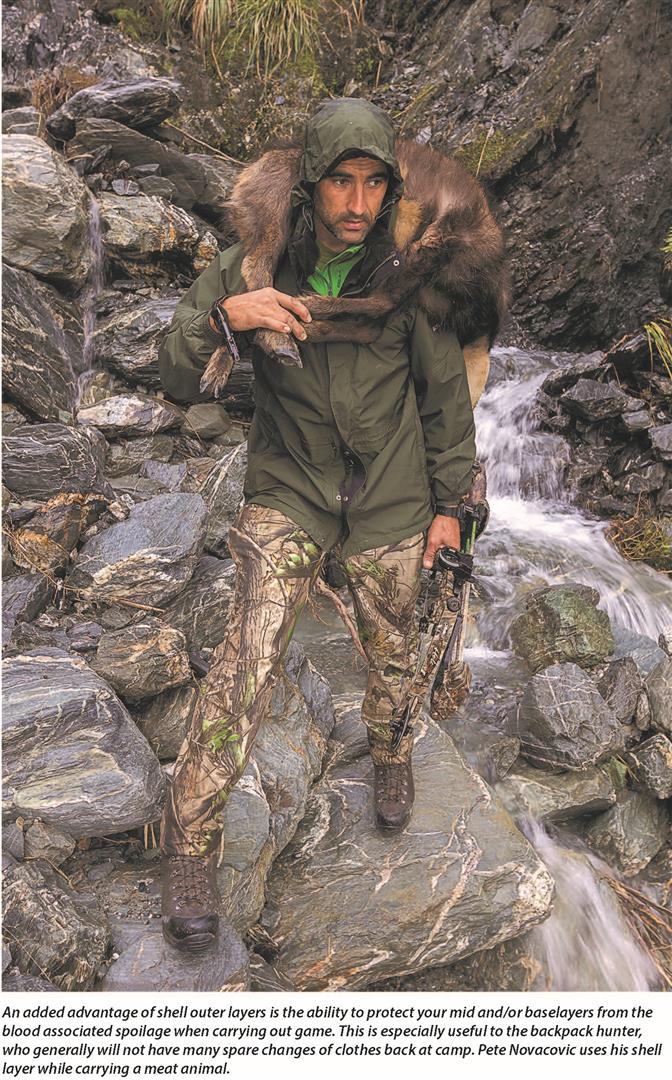
In a short period of time the hunter is within shooting range, the stag has its head down feeding broadside to the hunter and is unaware of his presence. A well placed shot harvests the stag quickly and efficiently. Soon the hunter has the antlers strapped to his pack with all the meat he can carry, he will
need to return tomorrow for the remainder. He has little time before sunset and needs to move quickly to get back to camp before dark.
With all other layers inside his pack, he now travels only with his base layer. He knows he will be perspiring heavily the whole way with his pack weight being so heavy, so keeping his mid layer dry will be important. He will need it for use back at camp.
The hunter returns to camp just after sunset after a successful hunt. He was moving fast and is now saturated in sweat. In camp he all the shelter he needs, soon he will start a campfire. Even though there is no wind down at this elevation around his sheltered campsite, the onset of darkness has caused the temperature to drop quickly. In the meantime, to prevent radiant heat loss the hunter now puts his mid layer back on.
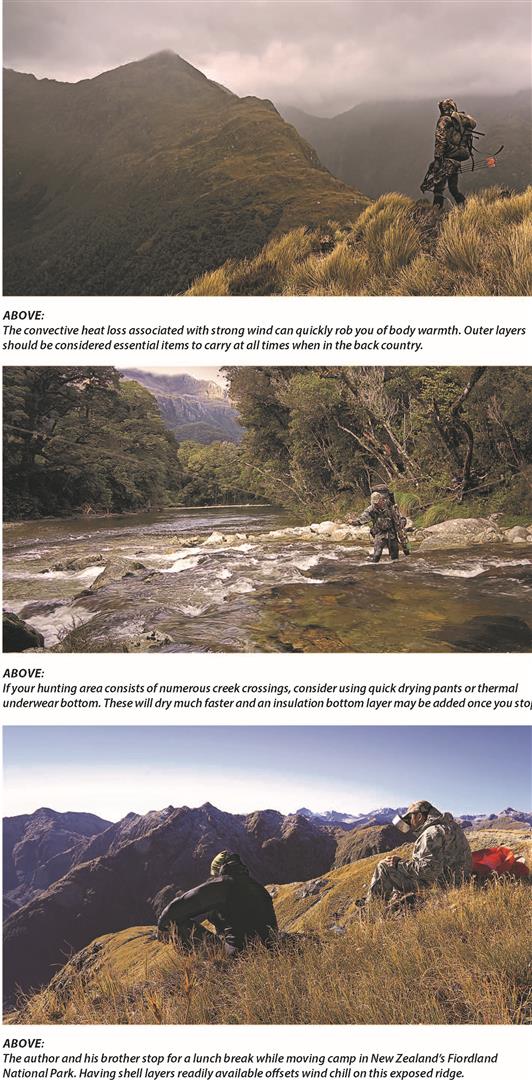
I hope this little scenario helps to demonstrate the advantages of a layering system, imagine how the same hunter would have fared if he only wore one heavy jacket. By effectively using his layering system the hunter was able to maintain adequate comfort levels, this in turn allowed him to keep his concentration
levels high.
Some points to consider
Bringing along a layering system on your hunting trips can be of great benefit. The knowledgeable hunter can also use his layers further, extending the versatility of this already versatile system.
Anticipate the conditions – Put your shell layer on before walking through thick wet bush, or onto a windswept ridge. Add your insulation layer before you get cold.
Wear breathable layers – Where conditions permit, avoid wearing your shell layers while stalking. The shell layers generally trap perspiration, opt for a more breathable layer where you can.
Avoid getting wet – Whether through sweat or rain, moisture in your clothing system will
chill you when you stop. When hiking into a hunting area in wet conditions (rain, showers, or even wet bush), keep your insulation layers in your pack to keep them dry, wearing only your shell and base layers. Your hiking work rate will generate body heat. When you stop or slow your work rate, you can add your dry
insulation layers that will be able to work much more efficiently in a dry state.
Begin Cool – If you know there is a big climb ahead of you first thing in the in the morning, begin your walk in a cooler state. You will warm up soon enough once you begin ascending. This way you avoid having to remove layers during your way up.
Avoid overheating – If the ambient temperature, wind or rain prevents the removal of
layers to cool down. Monitor your work rate to avoid heat build up and sweating.
Keep it handy – Ensure you have your layers readily available in your pack in the event of sudden weather changes. Don’t stow your rain gear down the bottom, having to empty pack contents for retrieval during sudden showers or rain.
Thanks for reading
